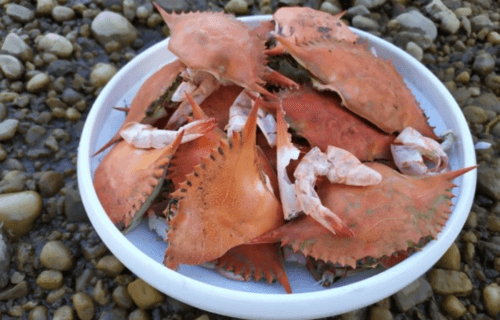COLLEGE PARK, Md. — If your electric car smells a little fishy, don’t worry, it may be the battery! Scientists have created a new sustainable battery using shellfish.
Specifically, they created the device out of chitin, the major structural component of crustaceans. The substance is abundant in the outer shells of crabs, lobsters, and shrimp. Exoskeletons of most insects also contain chitin.
The substance holds the key to satisfying the motor industry’s growing demand for renewable energy, according to the study authors. The new zinc battery has a biodegradable electrolyte containing chitin extracted from crab shells.
“Vast quantities of batteries are being produced and consumed, raising the possibility of environmental problems,” says lead author Liangbing Hu, director of the University of Maryland’s Center for Materials Innovation, in a media release.
“For example, polypropylene and polycarbonate separators, which are widely used in Lithium-ion batteries, take hundreds or thousands of years to degrade and add to environmental burden.”
Chitin has a wide range of uses
Chitin is a natural compound known as a biopolymer. Manufacturers already use it in medicines, pesticides, fertilizers, and as an edible film on foods.
Batteries use an electrolyte to shuttle ions back and forth between positively and negatively charged terminals. It can be a liquid, paste, or gel that includes flammable or corrosive chemicals. The new electrolyte is a gel comprising chitosan — a derivative of chitin.
“Chitosan is a derivative product of chitin. Chitin has a lot of sources, including the cell walls of fungi, the exoskeletons of crustaceans, and squid pens,” says Hu. “The most abundant source of chitosan is the exoskeletons of crustaceans, including crabs, shrimps and lobsters, which can be easily obtained from seafood waste. You can find it on your table.”
In terms of being biodegradable, microbes are capable of breaking down about two-thirds of the battery. The chitosan electrolyte crumbled completely within five months. It left behind the metal component zinc – rather than lead or lithium – which is also recyclable.
“Zinc is more abundant in earth’s crust than lithium,” Hu explains. “Generally speaking, well-developed zinc batteries are cheaper and safer.”
The battery, described in the journal Matter, has an energy efficiency of 99.7 percent after 1,000 battery cycles. It could even store energy generated by large-scale wind and solar sources, for transfer to power grids.
The researchers plan to work on making batteries even more environmentally friendly, from the manufacturing process onwards.
“In the future, I hope all components in batteries are biodegradable,” Hu concludes. “Not only the material itself but also the fabrication process of biomaterials.”
South West News Service writer Mark Waghorn contributed to this report.


How absolutely tragic! Crustaceans are already being slaughtered at a higher rate than they can reproduce. Killing them causes a chain of wildlife starvations and environmental impacts, it is NOT sustainable. How many innocent beings will have to suffer and die for our petty human wants. Our knowledge is vast, but our wisdom VERY tiny. Leave the ocean life alone and ride your freaking bike! This is just another nail in the biosphere’s coffin. How absolutely sad.
Don’t mushrooms contain chitin also? Seems better to extract it from something without a face.
it mentioned “fungus” which is what mushrooms are. In the long run I’m sure it will be easiest and most abundant wins if the shells are currently simply put in land fills as trash by the millions of tons that will be a win over all.